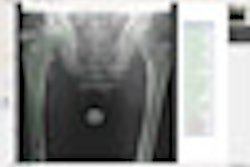
NEW YORK (Reuters Health), Nov 4 - Young patients with breast cancer who undergo lumpectomy followed by radiotherapy using tangential fields are at increased risk of contralateral breast cancer. This is particularly true for those with a positive family history of breast cancer, Dutch and U.S. researchers report in the October 14 online issue of the Journal of Clinical Oncology.
Given these findings, lead investigator Dr. Maartje Hooning told Reuters Health, "We should define in more detail the subgroup that is genetically susceptible to radiation-induced breast cancer. In the present study, germ-line mutation test results for BRCA1, BRCA2, or other predisposing genes were not available. In future studies, we must find out to what type of mutations this radiotherapy-susceptibility applies."
In their study, Hooning of the Netherlands Cancer Institute, Amsterdam, and colleagues assessed the risk of contralateral breast cancer in more than 7,200 predominantly young patients who had been treated between 1970 and 1986.
In those under the age of 35 years at the time of first treatment, the hazard ratio for contralateral breast cancer was 1.78, compared to a hazard ratio of 1.09 in those more than 45 years of age.
In women under the age of 45 years when treated, postmastectomy radiotherapy using direct electron fields led to a significantly lower radiation exposure to the contralateral breast than postlumpectomy radiotherapy using tangential fields. For the latter group compared to the former, the hazard ratio for contralateral breast cancer was 1.5.
Patients with three or more relatives with breast cancer experienced a 2.4-fold increased risk of contralateral breast cancer compared with patients with no affected relatives. Moreover, the joint effects of postlumpectomy tangential radiotherapy and a strong family history of breast cancer led to a hazard ratio for contralateral breast cancer of 3.52.
"Although the radiotherapy techniques of today will lead to a lower dose to the contralateral breast than the techniques presented in our study," concluded Hooning, "treating clinicians should be aware of the existing dose-response relationship for risk of contralateral breast cancer. Especially in young women, the radiation dose to the contralateral breast should be kept as low as possible."
By David Douglas
J Clin Oncol 2008;26.
Last Updated: 2008-11-04 10:20:52 -0400 (Reuters Health)
Related Reading
Family history of breast cancer confers lifetime elevated risk, May 14, 2008
Copyright © 2008 Reuters Limited. All rights reserved. Republication or redistribution of Reuters content, including by framing or similar means, is expressly prohibited without the prior written consent of Reuters. Reuters shall not be liable for any errors or delays in the content, or for any actions taken in reliance thereon. Reuters and the Reuters sphere logo are registered trademarks and trademarks of the Reuters group of companies around the world.



















